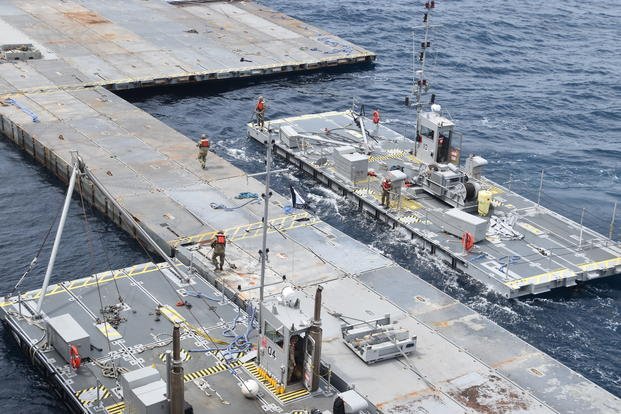Navy warships will help protect the U.S. military's soon-to-be-completed pier to deliver aid to starving Palestinians in Gaza, the Pentagon said Tuesday.
Pentagon spokesman Maj. Gen. Pat Ryder told reporters at a briefing Tuesday that Navy ships will be part of the security plan for the operation. A Navy official told Military.com that the sea service is assigning two destroyers to the mission.
The two ships will join the thousands of Israeli Defense Forces soldiers -- plus Israeli navy ships and Israeli air force planes -- that are dedicated to protecting the effort to move food and supplies into Gaza via the sea as Israel's crushing offensive against Hamas grinds on.
News of the Navy security mission comes as officials in the Pentagon say that the operation to move aid is nearly ready to swing into action in the coming days. The safety of U.S. forces positioned off the coast remains a concern amid the war in Gaza, which has killed large numbers of civilians, sparked regional violence and led to international controversy.
Last Thursday, Ryder told reporters that the construction of the two portions of the Joint Logistics Over-the-Shore, or JLOTS, system -- the floating pier and the causeway being constructed by the Army -- "have been completed."
"They are currently positioned offshore at the port of Ashdod, awaiting final movement," Ryder said.
Officials have said that sea conditions in the Mediterranean have prevented them from taking the nearly 550-yard causeway and driving it into the beach in Gaza.
Ryder has said that the soldiers and sailors running the operation have used the delay "to get ahead" and stage aid on the cargo ship USNS Roy P. Benavidez so that it's ready to go as soon as the floating causeway is in place.
A senior defense official said that the first shipload of aid aboard the Benavidez will be made up of 475 pallets, or 170 tons, of food -- enough to feed 11,000 adults and children for one month.
A senior military official who spoke with reporters in late April said that they expect the initial throughput of the effort to begin at "about 90 trucks a day ... and then quickly scale up to 150 trucks a day."
However, both military and civilian officials have repeatedly made clear that the JLOTS mission is meant only to be a supplement to the more traditional aid routes through land border crossings in Gaza. But aid has been slow to come in through those routes either due to closures or heavy screenings by Israeli officials.
At the beginning of April, Israeli forces conducted repeated airstrikes on a World Central Kitchen convoy of aid workers, killing seven.
After the outrage over the attack drew renewed attention to the situation in Gaza, the land crossing reopened and the senior military official said that, in the last weeks of April, the average aid flowing in via land has been "about 220 trucks a day."
Related: Gaza Pier Construction Begins Amid Concerns over Attacks on Troops and Aid Workers












